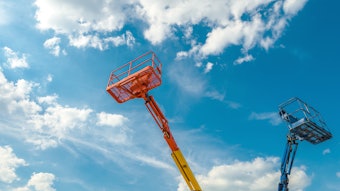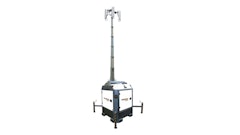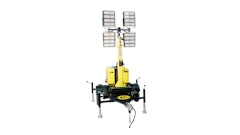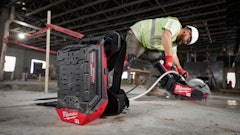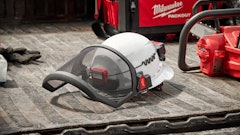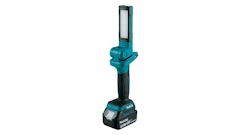
There's a new portable lighting solution available to illuminate your jobsite. Balloon lights are now cropping up on various projects, including building, drilling, paving, road repair and other sites.
These self-inflating illumination units are easy to use and extremely portable. As Marc James, product manager with Ingersoll Rand, explains, "You just plug and play."
Assembly of a balloon light is fast; it typically takes about five minutes to unpack, inflate and mount. For example, with Ingersoll Rand's BL2000 balloon light, you simply remove it from the storage case and plug it into a 120-volt/20-amp outlet (wall socket or generator). An internal fan inflates the shroud. "Tiny vent holes will provide circulation for cooling and prevent overinflation," says James.
Airstar Space Lighting's Sirocco Lighting Systems inflate in a similar manner and are equipped with a pressure sensor.
"When the unit reaches 90% pressure, the lamps automatically illuminate," says John Wessels, national sales manager - construction. "In less than two minutes, the system will self inflate."
Multiquip's Moonlight lighting system eliminates the internal fan. Instead, the balloon is inflated with a rechargeable or battery-operated blower. "Eliminating the fan means dirt and other debris are not blown into the unit," says Juan Quiros, manager of product support. "This extends balloon and component life."
Airstar's units, as well as the Ingersoll Rand BL2000, are equipped with a filter in the base that eliminates this concern by preventing dirt and particles from entering the unit.
Most balloon lights offer various configurations that can be mounted to mobile pieces of equipment such as pavers or rollers, tripods for stationary use, wheeled stands or even truck hitches.
What are the benefits?
The greatest advantage of balloon lights versus light towers is the glare-free lighting.
"With a balloon unit, the light is diffused," James explains. "It's softer and has no shadows. More and more DOTs are spec'ing glare-free lighting into contracts, so this is really important for roadbuilding and repair."
Wessels adds, "Unlike traditional lights, these units don't cast shadows. You're not blinded when you look directly at the light, nor is there a reflection off the ground or equipment. These lights make nighttime work not only safer for the workers, but also for drivers."
Balloon lights are also very quiet - or as quiet as the source powering them. This helps during night operations where noise could be a problem.
Another benefit is portability. Balloon lights can be easily transported in their storage cases in the bed of a pickup truck. There are no outriggers to set, masts to crank, or lights to position. They can also move with the job when they're mounted to a piece of equipment or on a wheeled stand.
What are the disadvantages? Traditional light towers will give you a wider area of light coverage and can be tilted to illuminate other areas. And because of a balloon light's portability, you must make sure the unit is secured and properly anchored for safety. And watch out for overhead power lines.
Traditional light towers, which are more costly and not as mobile, still have their place, says James. "It really depends on the application," he states. "Both types have their markets. Balloon lights are not going to replace traditional light towers. They just offer another solution."
Are they fragile?
With the word "balloon" in its description, you can't help but wonder if balloon lights can stand up to severe jobsite conditions, such as wind, rain, temperature variations, etc. But suppliers are quick to state they are quite capable of handling tough conditions.
"The envelopes (outer shell of balloon lights) are made of complex textures to give the balloon a long life," says Wessels. "These textures are ripstop, tight, and resistant to weather conditions - rain or snow."
Most units can withstand winds from 55 to 65 mph. Airstar's Sirocco 2000W, which is designed to mount to pavers and rollers, is wind resistant up to 68 mph.
Wind stability can depend on how the unit is mounted, says Quiros. "The end user should take care to use sandbags or other means to properly anchor the pole or stand to which the unit is mounted," he states. "The balloon light is as sturdy as what it's mounted to."
Temperature fluctuations can affect the balloon depending upon what it is filled with. For example, if the balloon is filled with helium, a difference in temperature can make the helium volume vary. However, if the balloon is filled with ambient air, it's not as temperature sensitive.
While balloon lights are very durable, normal precautions must be taken to protect the bulb and balloon from abuse. Several models have built-in spring suspension lighting harnesses that allow the lights to sustain heavy vibration during transport without damaging the lamps.
There is minimal maintenance with balloon lights. The envelopes can rip or tear, but most manufacturers supply repair kits with their units. The only other maintenance is bulb replacement, with bulbs readily available from dealers. Bulbs generally last up to 10,000 hours.
Rent or purchase?
Because they are portable, inexpensive, and easy to use, balloon lights can be a cost-effective addition to your fleet. But if only short-term or occasional lighting is required, you may want to check into rental as an option. While markets vary, rental rates range from $75 to $100 a day or up to $250 a week.
Regardless of how you acquire them, clearly balloon lights can offer an effective lighting alternative on certain jobsites. "When you need a true mobile light source that provides silent, glare-free illumination, balloon lights fill that need," says James.
Lisa Cleaver is managing editor of Asphalt Contractor.
A Unique Lighting Option The tower body is made of a lightweight ripstop material that acts as a light tube to give off a very even matt lighting that is easy on the eyes. The 875-watt metal halide bulb reaches full brightness after about five minutes. As an added benefit, the light tower offers low noise levels. "The unit is so quiet you can stand beside it and carry on a normal conversation," says Patrick Giroud with GTM Canada Inc. |





